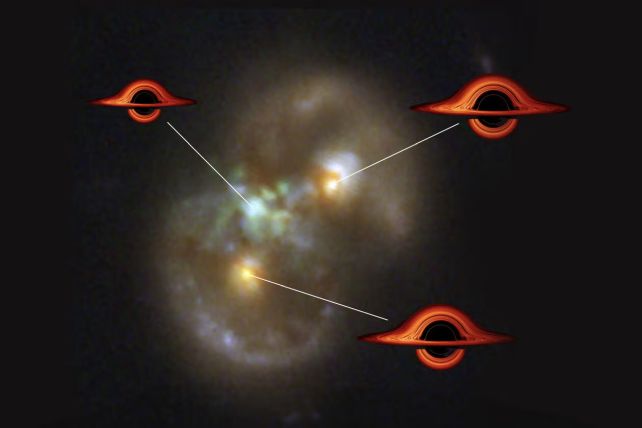Supermassive black holes represent one of the biggest head-scratchers in the Universe. These behemoths weighing millions to tens of billions of Suns lurk at the center of just about every galaxy – the gravitational heart around which stars and planets and clouds of shimmering gas whirl in an intricate dance.
What we don't know is how these giants are born. Do they grow slowly, a gradual accumulation of mass from a seed the size of a single star's core? Or do they form directly from the collapse of giant clouds of material in space so dense that they cannot fight the inward pull of their own gravity?
A new discovery might – at least partially – give us an answer.
A pair of galaxies whose light has traveled for 8.3 billion years contains what astronomers believe is a supermassive black hole in the act of forming. If this is the case, it is the first time we have seen this process in action, a vital and unprecedented piece of the supermassive black hole formation puzzle.
Related: Earliest Black Hole Ever Seen Discovered at The Dawn of Time
"We think we're witnessing the birth of a supermassive black hole – something that has never been seen before," says astronomer Pieter van Dokkum of Yale University in the US.

This 'smoking gun' was found in a pair of galaxies in the act of colliding, oriented so that their configuration resembles a figure-eight, or infinity symbol. The researchers have named the object the Infinity galaxy, and it really is an oddity discovered in a search for oddities in the JWST COSMOS-Web survey of the Universe.
Each of the galaxy's two lobes has its own brightly glowing nucleus, with a supermassive black hole lurking therein. However, where the two lobes overlap and intersect, a third brightly glowing blob can be seen.
The researchers carefully studied this blob in multiple wavelengths, and were stunned to find the signatures of a third supermassive black hole, smack bang between the two lobes of the Infinity galaxy.
"We asked ourselves: how can we make sense of this?" van Dokkum says.
A careful, closer analysis of the material around the anomalous black hole suggested that it was newly formed, sitting in an extended region of hot, shocked gas. This suggests a new mechanism for black hole formation, based on the direct collapse model.
"In this case, two disk galaxies collided, forming the ring structures of stars that we see. During the collision, the gas within these two galaxies shocks and compresses. This compression might just be enough to have formed a dense knot that then collapsed into a black hole," van Dokkum explains.
"While such collisions are rare events, similarly extreme gas densities are thought to have been quite common at early cosmic epochs, when galaxies began forming."

Related: A Supermassive Black Hole Is on a Collision Course With The Milky Way
Galactic collisions have long been proposed as one mechanism whereby supermassive black holes can grow. When the two objects merge, their central black holes are inexorably gravitationally drawn together, eventually colliding and merging to form a bigger black hole.
Such galaxy collisions are also thought to be a crucial part of how galaxies grew in the early Universe; the Milky Way is thought to have undergone multiple such mergers.
This hypothesis is sound, but it doesn't answer the question about how the less-massive, but still supermassive, black holes at the centers of these galaxies formed. A growing body of evidence supports the direct collapse model, but we've not seen the process in action.
The Infinity galaxy is a little more halfway through the Universe's 13.8-billion-year history, but the early Universe was full of dense clouds of hydrogen gas that could have rammed into each other, creating shocked knots of huge amounts of material in a very similar way. The discovery, therefore, is a compelling argument for the direct collapse model at the very beginning of the Universe.
"This is as close to a smoking gun as we're likely ever going to get," van Dokkum says.
Two papers outlining the discovery have been submitted to The Astrophysical Journal Letters. They can be found on arXiv here and here.
